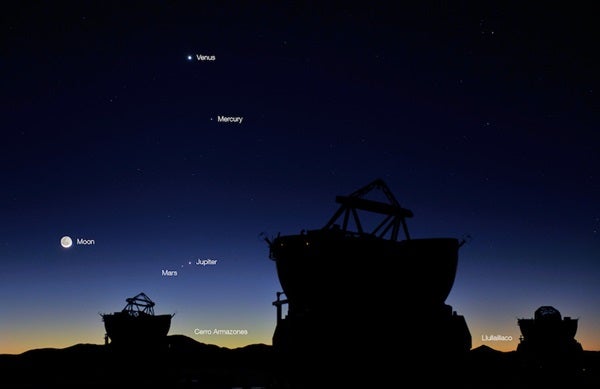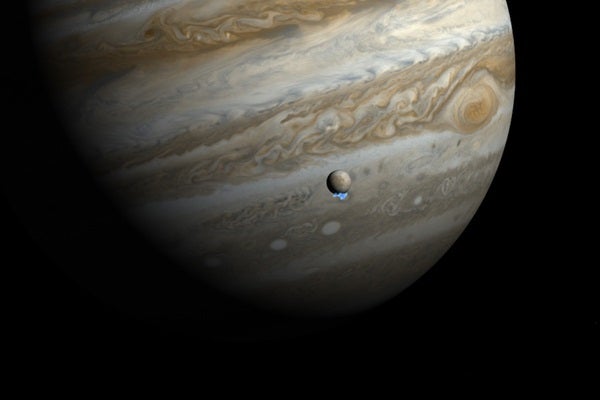Grab your binoculars or telescope and hunt down asteroid 20 Massalia this week. The 9th-magnitude minor planet lies among the background stars of eastern Taurus and climbs highest in the south during the late evening hours. Start at 3rd-magnitude Zeta (ζ) Tauri, the star that marks the tip of the Bull’s southern horn. Then, take a quick look at the Crab Nebula (M1) 1° to the northwest before sliding 1.6° farther west to find 5th-magnitude 114 Tau. Massalia currently lies 1° due west of this star.
Saturday, January 6
For those who recently caught the observing bug, the so-called Summer Triangle must seem like a huge misnomer. That’s because this asterism remains on view after darkness falls in early January. Look for Vega, the fifth-brightest star in the sky and the brightest triangle member, in the northwest after nightfall. Deneb lies above Vega and nearly halfway to the zenith. Deneb marks the top of another asterism, the Northern Cross, which stands nearly straight up from the horizon on January evenings. Altair, the third triangle member, appears due west and slightly lower than Vega. The trio remains on view until Altair sets around 7 p.m. local time.
Sunday, January 7
Mars and Jupiter enjoy a stunning conjunction this morning. The two planets stand just 16′ apart (half the Full Moon’s diameter). This is the closest they’ve been since September 2004, though they were then just a few degrees from the Sun and lost in our star’s glare. They haven’t been this close and visible since January 1998. The pair rises shortly before 3 a.m. local time and looks great with the naked eye or binoculars. A telescope shows both in a single low-power field of view. Mars appears 5″ across while Jupiter, despite lying three times farther away, spans 34″.
Although people in the Northern Hemisphere experienced the shortest day of the year more than two weeks ago (at the winter solstice December 21), the Sun has continued to rise slightly later with each passing day. That trend stops this morning for those at 35° north latitude. Tomorrow’s sunrise will arrive about two seconds earlier than today’s. This turnover point depends on latitude. If you live farther north, the switch occurred a few days ago; closer to the equator, the change won’t happen until later in January.
Last Quarter Moon occurs at 5:25 p.m. EST. The Moon doesn’t rise until after midnight, however, by which time it will appear slightly less than half-lit. It climbs highest in the south during morning twilight. The Moon spends the morning hours among the background stars of Virgo the Maiden.
Tuesday, January 9
The variable star Algol in Perseus appears faintest at 12:56 a.m. EST tomorrow morning, when it shines at magnitude 3.4. If you start watching it immediately after darkness falls this evening, you can see it dim from its peak brightness (magnitude 2.1) to minimum and then rise back to maximum all in a single night. This eclipsing binary star runs through a cycle from minimum to maximum and back every 2.87 days, but the drop from peak brightness and subsequent rise lasts only about 10 hours. Algol appears nearly overhead after darkness falls and descends toward the northwestern horizon after midnight.
Venus and Pluto both pass on the far side of the Sun from our perspective today. Venus passes through conjunction first, at 2 a.m. EST, followed by Pluto three hours later. If they were visible in the Sun’s glare, Venus would appear 0.7° south of our star and Pluto would lie 0.4° north of the Sun.
Wednesday, January 10
Observers who target Jupiter through their telescopes this morning can see two moons disappear simultaneously. Both Io and Europa pass into the giant planet’s shadow at 5:28 a.m. EST. For the best views, track the pair for the half-hour leading up to the eclipse and then watch them disappear over several minutes.
This artist’s concept depicts Jupiter and its moon Europa using actual Jupiter and Europa images in visible light. The faint water vapor plumes of Europa, which were imaged by Hubble in ultraviolet light, have been superimposed on the image. Though the plumes are accurately sized, their brightness has been enhanced.
A waning crescent Moon joins Mars and Jupiter for a stunning predawn display. Mars stands 4.6° south of the Moon while Jupiter lies 2.1° west of the Red Planet. Use binoculars for a close-up view or just enjoy the scene with your naked eye.
Friday, January 12
The brightest star in the night sky puts on a nice show January evenings. Gleaming at magnitude –1.5, Sirius shines nearly four times brighter than the next brightest star visible from mid-northern latitudes: Arcturus in the constellation Boötes. Sirius currently rises shortly after 6 p.m. local time and ascends in the southeast throughout the evening hours.
Saturday, January 13
Look low in the southeast before dawn to find two bright planets standing next to each other. Mercury appears brighter, shining at magnitude –0.3, while Saturn glows at magnitude 0.5. Both lie 7° above the horizon a half-hour before sunrise, with Saturn 0.6° (about the diameter of a Full Moon) north of the inner planet. Binoculars will afford the best view of this pretty conjunction.
Sunday, January 14
Although Uranus reached opposition nearly three months ago, it remains a tempting target. The outer planet climbs highest in the south around 6 p.m. local time, when it appears two-thirds of the way to the zenith. The magnitude 5.8 world lies in southeastern Pisces, 3.5° west of the 4th-magnitude star Omicron (ο) Piscium. Although Uranus shines brightly enough to glimpse with the naked eye under a dark sky, binoculars make the task much easier. A telescope reveals the planet’s blue-green disk, which spans 3.5″.
The Moon reaches apogee, the farthest point in its orbit around Earth, at 9:10 p.m. EST. It then lies 252,565 miles (406,464 kilometers) from Earth’s center.












